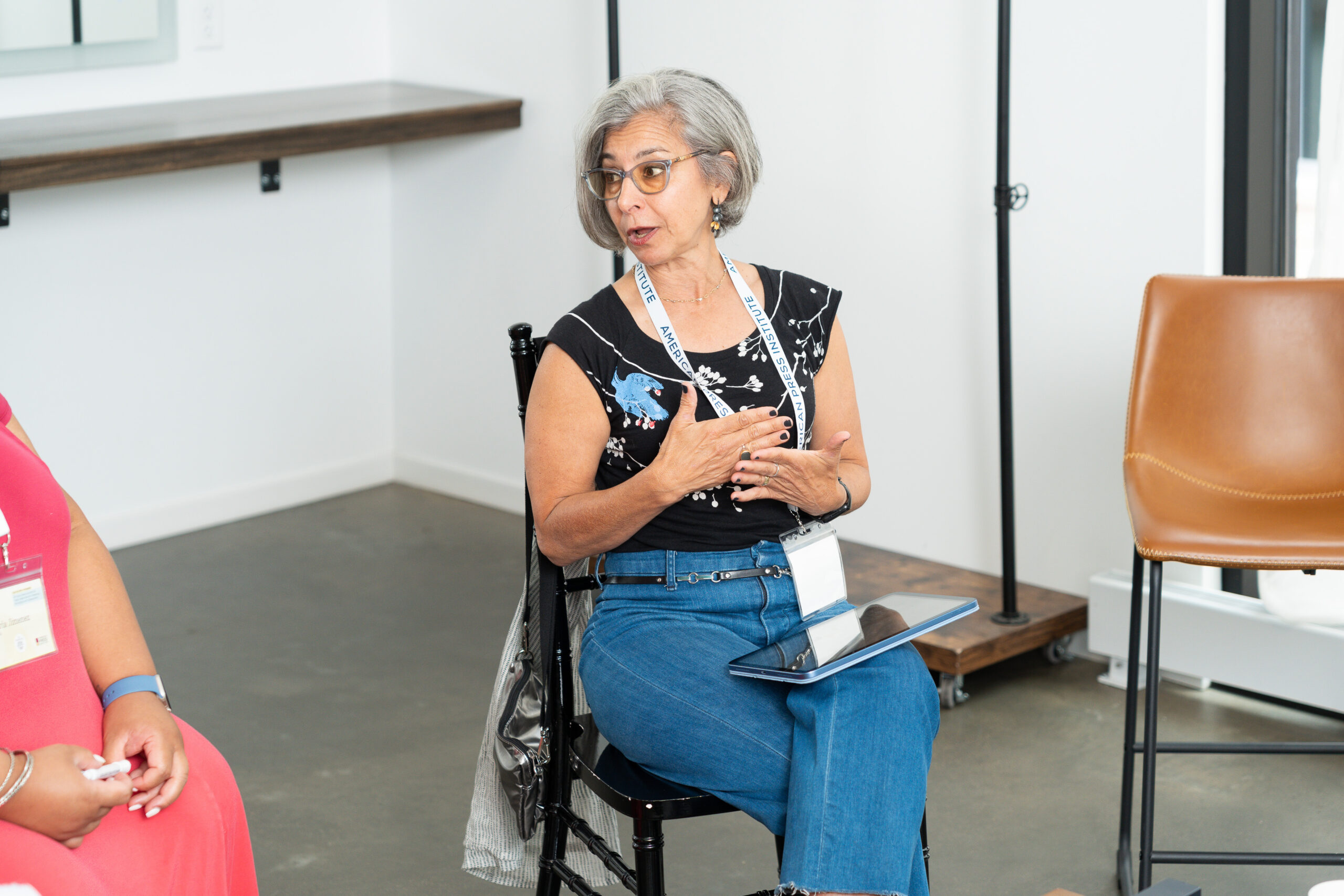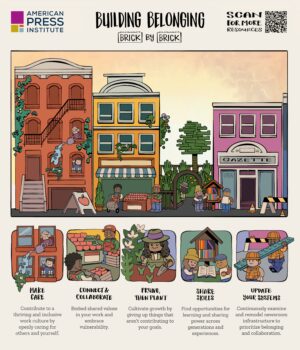8 ideas for managing generational tensions in your news organization
Marci Alboher, CoGenerate,
Marci Alboher of CoGenerate leads a small-group discussion on navigating generational tensions at an API Local News Summit in Minneapolis. (Photo by Darin Kamnetz)
Here’s an idea to steal and adapt: With the possibility of four or five generations working side by side, the workplace may offer the best chance for decreasing generational tension and increasing cross-generational collaboration.This is a series on Better News to a) showcase innovative/experimental ideas that emerge from the Knight-Lenfest Newsroom Initiative and b) share replicable tactics that benefit the news industry as a whole.
These ideas come from Marci Alboher, an author and vice president for narrative strategy at CoGenerate, a national nonprofit working to bridge generational divides. Earlier in her career, she was a journalist and created the Shifting Careers column and blog for the New York Times.
In July 2024, Alboher participated in a two-day API Local News Summit for Table Stakes Alumni focused on fostering belonging and collaboration and based her insights below on that experience.
Generational tensions are dominating headlines. They’re also dominating newsrooms, as I learned from spending two days in Minneapolis with an impressive group of newsroom leaders who are alums of the Table Stakes Local News Transformation Program. The group was assembled by the American Press Institute for a Local News Summit focused on fostering belonging and collaboration.
We live in the most age-diverse society in human history, and yet the generations are often segregated where we live, learn, play and worship. With the possibility of four or even five generations working side by side, the workplace — in this case, the newsroom — may offer the best chance for decreasing generational tension and increasing cross-generational collaboration (what my colleagues and I call “cogeneration”).
The challenge extends beyond HR practices to how we cover the news and how news organizations stay in business. News leaders will need to create thriving multigenerational staff teams to reach and engage with younger audiences without alienating long-term subscribers.
Here are eight ideas for bringing cogeneration to your news organization:
1. Share the power.
Journalists often share bylines. Could older and younger journalists co-manage a newsroom or practice co-leadership in other ways? College student publications and student-led podcasts are leading the way. In some cases, a veteran media entrepreneur or adviser raises the money and serves as a mentor, while a student leader runs the newsroom with complete editorial control.
2. Give younger journalists opportunities to grow and lead.
Many younger journalists arrive on the job with strong personal brands and many social media followers. How can you build on that kind of experience to increase your engagement with younger audiences? Consider creating platforms for journalists to connect directly with community members. Inside your newsroom, ensure that younger people have voices and positions on key committees and decision-making bodies. Outside your newsroom, give up-and-comers the chance to represent your organization at conferences and industry events and in leadership-training opportunities.
3. Create spaces for cross-generational exchange and partnerships.
Older and younger journalists can learn a lot from each other. In one scenario shared at the summit, a veteran economics reporter was paired with a young TikTok aficionado. The result: a viral personal finance series reaching a completely new audience. Where could you see this kind of partnership and mutual mentoring in your own newsroom?

Marci Alboher (left) of CoGenerate leads a small-group discussion on navigating generational tensions at an API Local News Summit in Minneapolis. (Photo by Darin Kamnetz)
4. Listen to younger staffers.
Emerging leaders have a lot to teach about things like managing wellness/mental health issues, capturing and editing video and making the case that 24/7 availability isn’t always necessary. They have perspectives on issues that deserve to be heard. For example, many younger journalists want to show up to the newsroom as their “full selves,” without putting parts of their identities aside as they report the news. Are you open to difficult conversations, such as reexamining what it means to be objective? How might you create forums to listen to your younger staffers?
5. Listen to veteran staffers.
They know history. They have deep networks and extensive knowledge of their beats. And they have covered news cycles that continue to repeat. They also have lived experience to share on how to avoid burnout and manage the stress that comes with the job. Consider creating forums for them to share knowledge and mentorship (whether one-to-one or one-to-many) both within the newsroom and out in the community.
6. Offer phased retirement programs.
Keeping older staffers on the job longer in part-time roles has benefits inside and outside the newsroom. Experienced journalists can share institutional knowledge and pass on vital information about navigating thorny reporting issues or covering particular beats, while experimenting with various ideas for their encore careers before they retire.
7. Recognize that age and generation are never the only thing in the room.
When partnering across generations, it’s common to cross other identities like gender identification, sexual orientation and race/culture as well. By forging intergenerational partnerships, you can increase your ability to work across other lines of difference and understand people who have different lived experiences than your own.
8. Accept that ageism runs both ways.
No one is immune from generalizing about different age groups. At the gathering, I heard many versions of “older people won’t learn tech/are coasting into retirement” and “younger people don’t have historical perspective/aren’t loyal.” When you step away from stereotyping and try instead to listen to someone’s lived experience, you may see that people of all ages and generations are struggling with many of the same issues.
